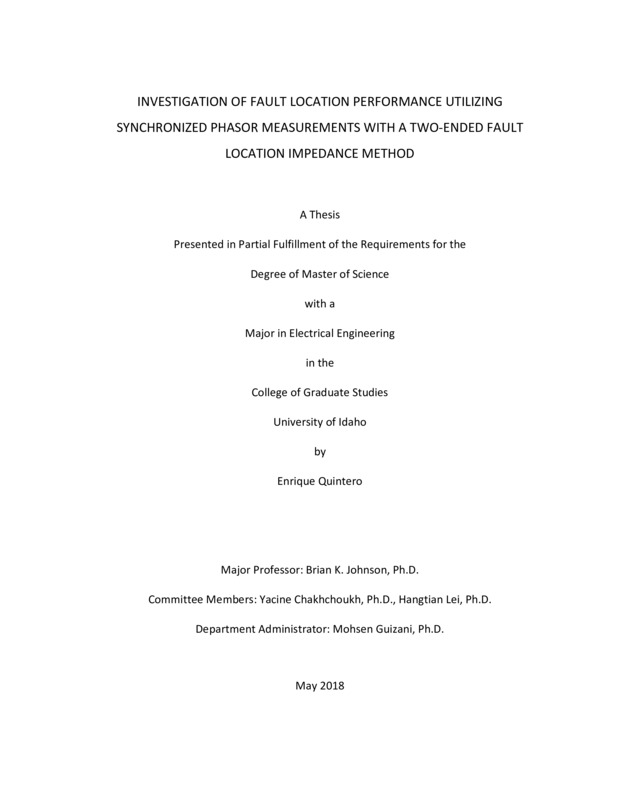Investigation of fault location performance utilizing synchronized phasor measurements with two-ended fault location impedance method
Quintero, Enrique. (2018-05). Investigation of fault location performance utilizing synchronized phasor measurements with two-ended fault location impedance method. Theses and Dissertations Collection, University of Idaho Library Digital Collections. https://www.lib.uidaho.edu/digital/etd/items/quintero_idaho_0089n_11309.html
- Title:
- Investigation of fault location performance utilizing synchronized phasor measurements with two-ended fault location impedance method
- Author:
- Quintero, Enrique
- Date:
- 2018-05
- Embargo Remove Date:
- 2021-03-28
- Program:
- Electrical and Computer Engineering
- Subject Category:
- Electrical engineering
- Abstract:
-
ABSTRACT
Transmission lines are an essential part of the electrical grids. Thus, utilities cannot afford to have any transmission line out service because it can result in power outages and causes overloading other lines in the same grid. However, transmission lines are exposed to faults caused by short circuits, birds, adverse weather conditions, and human made accidents. Transmission line faults can be temporary or permanent. Temporary faults are mostly self-cleared. But, permanent faults do not self-cleared and cause damage to transmission line infrastructure. Most of these faults result in mechanical damage to power lines, poles, or insulators which need to be repaired before returning the line to service. For this reason, transmission line faults must be located accurately to allow field crews arrive at the scene and repair the faulted equipment as soon as possible.
The most obvious method to locate the faulted equipment is just to patrol the whole line, but one of the main obstacles following that method are the geographical layout in some sections of the line making difficult for the field crews accessing to the scene, the long time it takes to patrol the line and the associated high cost which makes it uneconomical. Meanwhile, if the utility has a software tool to calculate fast and accurate fault location under any power system conditions, the utility will enhance the restoration time of the line with less cost and consequently it will short customer outage time by pointing field crews to narrow range to check.
Fault location algorithms are one method for utilities use to detect fast and accurate fault location. However these fault location algorithms are typically embedded in fault locator devices or protective relays. This is an obstacle because in order to get the fault location out those devices, they need to be interrogated and normally these devices are located in remote areas. Now with the advances in synchrophasor technology, it is possible to collect synchronized phasor measurements in a convenient central location such as operating center or dispatch center and perform fast and accurate fault location based on synchronized phasor measurements.
For this thesis, an impedance based fault location technique will be used because it is the most simple and practical method for implementation. However, this fault location technique in conjunction with relay data is known for being susceptible to a number of sources of errors. So by utilizing real-time and very accurate synchronized phasor measurement data, this thesis will investigate how accurate the impedance based fault location technique result.
- Description:
- masters, M.Engr., Electrical and Computer Engineering -- University of Idaho - College of Graduate Studies, 2018-05
- Major Professor:
- Johnson, Brian K
- Defense Date:
- 2018-05
- Identifier:
- Quintero_idaho_0089N_11309
- Type:
- Text
- Format Original:
- Format:
- application/pdf
- Rights:
- In Copyright - Educational Use Permitted. For more information, please contact University of Idaho Library Special Collections and Archives Department at libspec@uidaho.edu.
- Standardized Rights:
- http://rightsstatements.org/vocab/InC-EDU/1.0/

